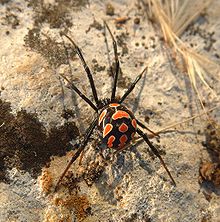Latrodectus tredecimguttatus
| Latrodectus tredecimguttatus | |
|---|---|
 |
|
| Female L. tredecimguttatus | |
| Scientific classification | |
| Kingdom: | Animalia |
| Phylum: | Arthropoda |
| Subphylum: | Chelicerata |
| Class: | Arachnida |
| Order: | Araneae |
| Infraorder: | Araneomorphae |
| Family: | Theridiidae |
| Genus: | Latrodectus |
| Species: | L. tredecimguttatus |
| Binomial name | |
|
Latrodectus tredecimguttatus Rossi, 1790 |
|
Latrodectus tredecimguttatus, sometimes known as the Mediterranean black widow, the European black widow, or the steppe spider, is a species in the genus Latrodectus (widow spiders). It is commonly found throughout the Mediterranean region, ranging from Portugal to southwest and central Asia, hence the name. Specimens from central Asia are also known by the binomial name Latrodectus lugubris; that name, however, is now considered improper, though it is still commonly found in the literature. Latrodectus tredecimguttatus was previously considered a Latrodectus mactans subspecies.
L. tredecimguttatus bears different names in different regions. For example, in Southern France it is called Malmignatte and in Italy is called malmignatta. Throughout the Central Asia and Eastern Slavic region, the name karakurt is most often applied. The words kara, meaning "black", and kurt, meaning "wolf" (the word also means grub worm or maggot, which the spider is most likely named for), come from the Turkish language (Turkic languages).
L. tredecimguttatus is black in color, similar to most other widow species, and is identified by the thirteen spots which are found on its dorsal abdomen (the species name is Latin for "with thirteen spots"). These spots are usually red in colour, but may also be yellow or orange. It is otherwise similar to other species in the genus Latrodectus. The Mediterranean widow primarily lives in steppes and other grasslands, and can be a significant problem in areas where grain is harvested by hand. The female of the species has a body length of about 7–15 mm (0.28–0.59 in), while the male is smaller and reaches 4–7 mm (0.16–0.28 in) at best. Only the female spider's bite is dangerous (either for humans or cattle) as the male cannot penetrate the relatively thick epidermis.
Like all Latrodectus species, L. tredecimguttatus has a painful bite that is fatal in rare cases. They are not in close association with humans generally, although epidemics of bites have been reported. There are many reports of Ukrainian farm workers receiving bites while working in the fields. The LD-50 of L. tredecimguttatus venom has been measured as 0.59 mg/kg, and separately again as 0.59 mg/kg (with a confidence interval of 0.33–1.06).
...
Wikipedia
